方位介词讲义与习题(精华版)
- 格式:docx
- 大小:26.62 KB
- 文档页数:8
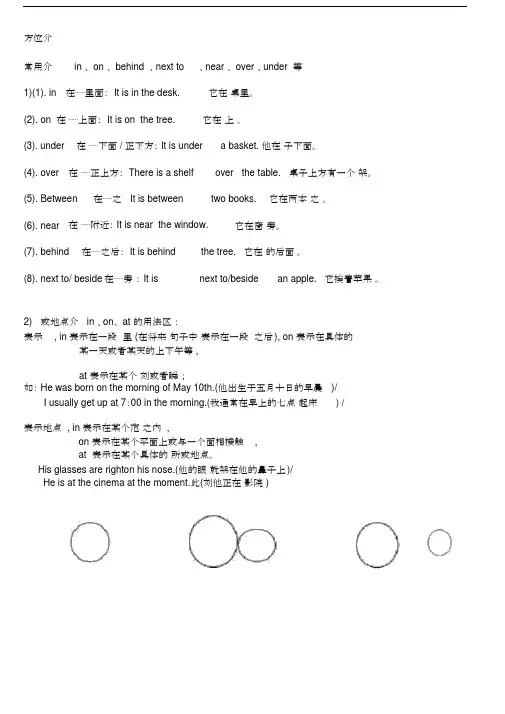
方位介常用介in 、 on 、 behind 、next to 、near 、 over 、under 等1)(1). in 在⋯⋯里面: It is in the desk. 它在桌里。
(2). on 在⋯⋯上面: It is on the tree. 它在上。
(3). under 在⋯⋯下面 / 正下方: It is under a basket. 他在子下面。
(4). over 在⋯⋯正上方: There is a shelf over the table. 桌子上方有一个架。
(5). Between 在⋯⋯之 It is between two books. 它在两本之。
(6). near 在⋯⋯附近: It is near the window. 它在窗旁。
(7). behind 在⋯⋯之后: It is behind the tree. 它在的后面。
(8). next to/ beside在⋯⋯旁:It is next to/beside an apple. 它挨着苹果。
2)或地点介 in 、on、 at 的用法区:表示 , in 表示在一段里 (在将来句子中表示在一段之后), on 表示在具体的某一天或者某天的上下午等 ,at 表示在某个刻或者瞬;如: He was born on the morning of May 10th.(他出生于五月十日的早晨)/I usually get up at 7:00 in the morning.(我通常在早上的七点起床) /表示地点 , in 表示在某个范之内 ,on 表示在某个平面上或与一个面相接触,at 表示在某个具体的所或地点。
His glasses are righton his nose.(他的眼就架在他的鼻子上)/He is at the cinema at the moment.此(刻他正在影院 )B A B A B AB 在 A 里——用in A 和B 相(接壤)——用on A 和B 不相(不接壤)——用to3) in front of “在⋯之前”(范外)in the front of 表示“在⋯的前部”(范内)演1. The United States is ____ the south of Canada and ___ the east of Japan.A. to; inB. on; toC. in; besideD. at; on2 . Japan lies____ the east of China.A. on B/ to C. in D. with3. Jiangsu is___ the east of China, but Japan is ___ the east of China.A. to; inB. in; to .C. on; toD. to; on4.There are some trees_________ the classroomThere is a blackboard ____________ the classroom.5.—Look, there are many apples ______ the tree.—Yes. And a boy is picking apples ______ the tree now.A. in; onB. on; inC. in; inD. on; on6.When did you arrive ______school this morning?A. inB. atC. toD. with。
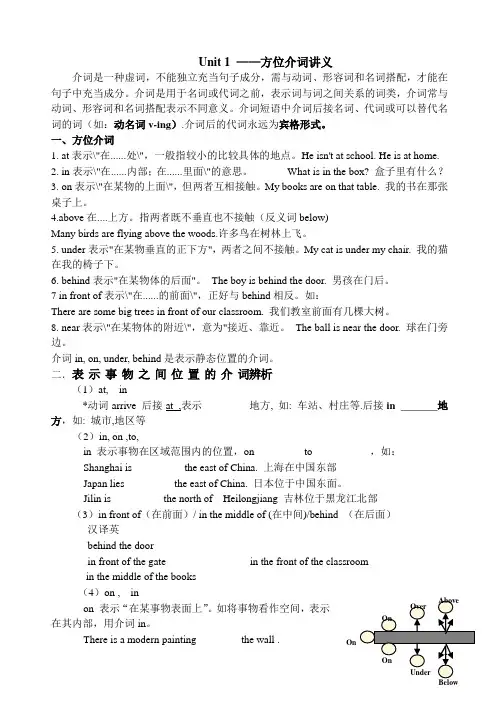
Unit 1 ——方位介词讲义介词是一种虚词,不能独立充当句子成分,需与动词、形容词和名词搭配,才能在句子中充当成分。
介词是用于名词或代词之前,表示词与词之间关系的词类,介词常与动词、形容词和名词搭配表示不同意义。
介词短语中介词后接名词、代词或可以替代名词的词(如:动名词v-ing).介词后的代词永远为宾格形式。
一、方位介词1. at表示\"在......处\",一般指较小的比较具体的地点。
He isn't at school. He is at home.2. in表示\"在......内部;在......里面\"的意思。
What is in the box? 盒子里有什么?3. on表示\"在某物的上面\",但两者互相接触。
My books are on that table. 我的书在那张桌子上。
4.above在....上方。
指两者既不垂直也不接触(反义词below)Many birds are flying above the woods.许多鸟在树林上飞。
5. under表示"在某物垂直的正下方",两者之间不接触。
My cat is under my chair. 我的猫在我的椅子下。
6. behind表示"在某物体的后面"。
The boy is behind the door. 男孩在门后。
7 in front of表示\"在......的前面\",正好与behind相反。
如:There are some big trees in front of our classroom. 我们教室前面有几棵大树。
8. near表示\"在某物体的附近\",意为"接近、靠近。
The ball is near the door. 球在门旁边。
介词in, on, under, behind是表示静态位置的介词。
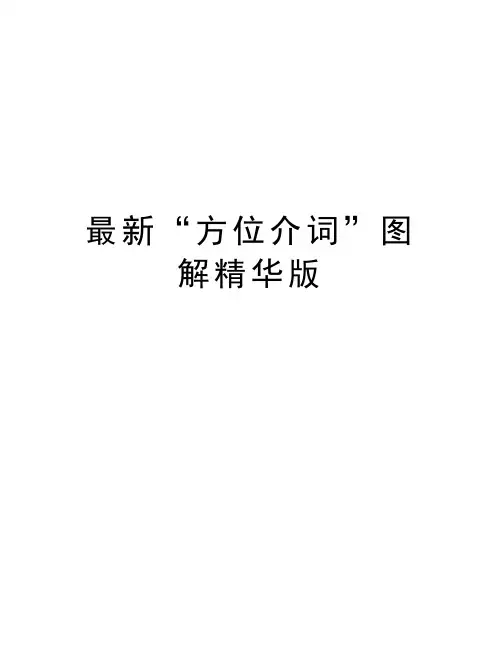
最新“方位介词”图解精华版初中英语重难点之“方位”介词介词的种类很多。
在初中英语中,有许多表示事物存在的方向和位置的介词,我们称之为方位介词。
如in(在……里),behind (在……后面),down (向下)等等。
其中有些方位介词的意义比较接近,在用法上很难区分,如on, over, above 都有“在……之上”的意思,但含义却不尽相同。
我们可以用三个图示配以简短的文字叙述来说明这三个介词的不同用法。
on(强调与物体的表面相接触)的部分方位介词用图示的方法归纳列举如下:几组方位介词的区别方位介词in, on, to的区别:1.in表示"在……范围内”,还表示“在…之中”Chongqing lies in the southwest of China.2.on表示“与……毗邻,接壤”Canada lies on the north of America.3.to表示方位,不接壤Hunan lies to the east of Zhejiang.表示地点位置的介词:1.at, in, on, toat 用于小地方,at school, at homeIn 用于大地方, in Beijing, in ChinaOn在……上面, on the map, on the tableTo到…… To Chongqing2.Above, over, onAbove在……上方(高过另一个物体,不强调垂直)The airplane flies above that tall building.(不在正上方)over在……上方(垂直上方)The bridge spans over the river.On在……上面(物体表面有接触)There's some water on the floor, so you should be careful.3.Below, under在……下面Under在……下(正下方)The cat lies under the chair.(正下方)Below在……下(不一定是正下方)The cat lies under the chair.(不是正下方)4.in front of, in the front of 在……的前面in front of 在外部的前面,两个东西是独立的,相反的是behind The building is in front of the hospital.The building is behind the hospital.In the front of在内部的前面,属于其中的一部分,相反的是at the back ofThe girl stands in the front of the classroom.The girl stands at the back of the classroom.5.Beside, near, byBeside在旁边Near在附近By在附近,非常靠近常见方位介词短语(一)、由介词in构成的方位介词短语1、in the front 在前面2、in the front row 在前排3、in the back row 在后排4、in the third row 在第三排5、in front of... 在...前面(范围之外)6、in the front of... 在...前部(范围之内)7、in the middle在中间8、in the street在街上9、in the middle of...在中间 10、in the tree在树上(指飞鸟等外来物)(二)、由介词at构成的方位介词短语1、at the front of...在...所在范围的前一部分2、at the back of...在...所在范围的后一部分3、at the foot of...在...脚下4、at the top of...在...顶部5、at the end of...在...尽头6、at the head of...在...前头7、at the(school)gate在(校)门口 8、at the station 在车站9、at No.2 Chang’an Road在长安路2号 10、at my uncle’s 在我叔叔家11、at home在家 12、at the doctor’s在医务室/在诊所(三)、由介词on构成的方位介词短语1、on the right/left在右(左)边2、on one’s right/left在某人的右(左)边3、on the desk/table在课桌/桌上4、on the right-hand/left-hand side在右/左手边5、on the blackboard在黑板上6、on/in the wall在墙上/里7、on the paper在纸上 8、on the tree在树上(指树上长的,结的东西)三、其它介词构成的方位介词短语1、next to靠近/贴近2、beside the desk在课桌旁3、behind the door在门后4、under the bed在床下5、near the window靠近窗户6、outside the gate在门外。
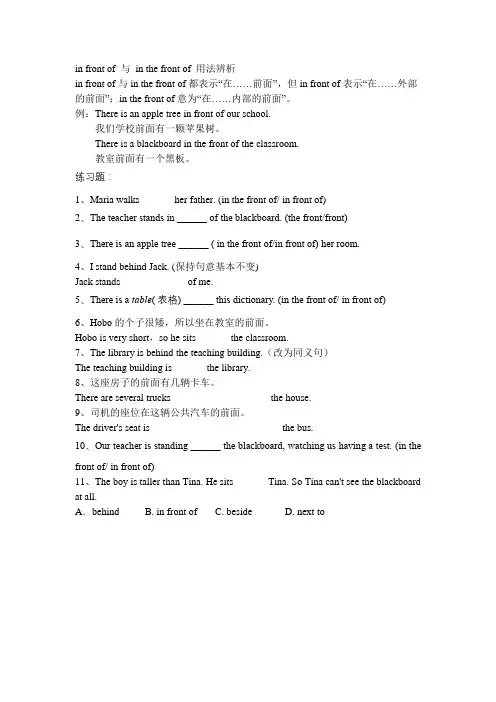
in front of 与in the front of 用法辨析in front of与in the front of 都表示“在……前面”,但in front of表示“在……外部的前面”;in the front of 意为“在……内部的前面”。
例:There is an apple tree in front of our school.我们学校前面有一颗苹果树。
There is a blackboard in the front of the classroom.教室前面有一个黑板。
练习题:1、Maria walks ______ her father. (in the front of/ in front of)2、The teacher stands in______of the blackboard.(the front/front)3、There is an apple tree ______ ( in the front of/in front of) her room.4、I stand behind Jack. (保持句意基本不变)Jack stands ______ ______ of me.5、There is a table(表格) ______this dictionary. (in the front of/ in front of)6、Hobo的个子很矮,所以坐在教室的前面。
Hobo is very short,so he sits ______ the classroom.7、The library is behind the teaching building.(改为同义句)The teaching building is ______ the library.8、这座房子的前面有几辆卡车。
There are several trucks ______ ______ ______ the house.9、司机的座位在这辆公共汽车的前面。

方位介词常用介词in、on、behind、next to、near、over、under等1)(1). in在……里面:It is in the desk.它在课桌里。
(2). on在……上面:It is on the tree.它在树上。
(3). under在……下面/正下方:It is under a basket.他在篮子下面。
(4). over在……正上方:There is a shelf over the table.桌子上方有一个书架。
(5). Between 在……之间It is between two books. 它在两本书之间。
(6). near在……附近:It is near the window. 它在窗户旁。
(7). behind在……之后:It is behind the tree. 它在树的后面。
(8). next to/ beside在……旁边:It is next to/beside an apple. 它挨着苹果。
2)时间或地点介词in、on、at的用法区别:表示时间时, in表示在一段时间里(在将来时句子中则表示在一段时间之后),on表示在具体的某一天或者某天的上下午等,at表示在某个时刻或者瞬间;如:He was born on the morning of May 10th.(他出生于五月十日的早晨)/I usually get up at 7:00 in the morning.(我通常在早上的七点钟起床) /表示地点时, in表示在某个范围之内,on表示在某个平面上或与一个面相接触,at则表示在某个具体的场所或地点。
His glasses are right on his nose.(他的眼镜就架在他的鼻子上)/He is at the cinema at the moment.(此刻他正在电影院)B A B A B AB 在A里——用in A和B相邻(接壤)——用on A和B不相邻(不接壤)——用to3) in front of “在…之前”(范围外)in the front of 表示“在…的前部”(范围内)实战演练1. The United States is ____ the south of Canada and ___ the east of Japan.A. to; inB. on; toC. in; besideD. at; on2 . Japan lies____ the east of China.A. on B/ to C. in D. with3. Jiangsu is___ the east of China, but Japan is ___ the east of China.A. to; inB. in; to .C. on; toD. to; on4. There are some trees_________ the classroomThere is a blackboard ____________ the classroom.A. in front ofB. in the front of5. —Look, there are many apples ______ the tree.—Yes. And a boy is picking apples ______ the tree now.A. in; onB. on; inC. in; inD. on; on6. When did you arrive ______school this morning?A. inB. atC. toD. with。
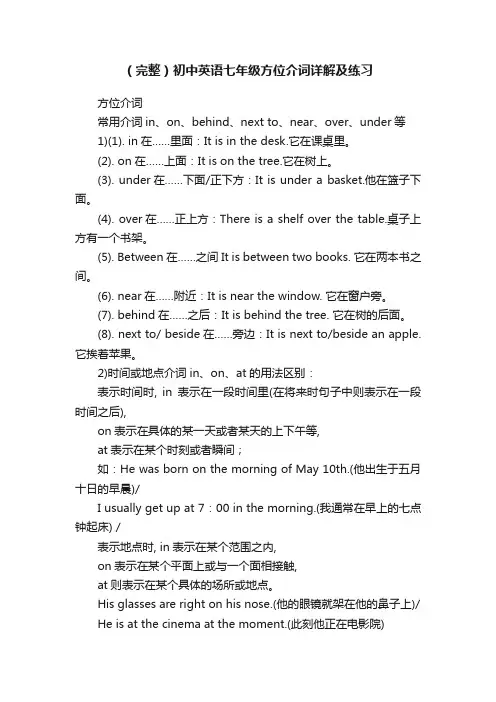
(完整)初中英语七年级方位介词详解及练习方位介词常用介词in、on、behind、next to、near、over、under等1)(1). in在……里面:It is in the desk.它在课桌里。
(2). on在……上面:It is on the tree.它在树上。
(3). under在……下面/正下方:It is under a basket.他在篮子下面。
(4). over在……正上方:There is a shelf over the table.桌子上方有一个书架。
(5). Between 在……之间It is between two books. 它在两本书之间。
(6). near在……附近:It is near the window. 它在窗户旁。
(7). behind在……之后:It is behind the tree. 它在树的后面。
(8). next to/ beside在……旁边:It is next to/beside an apple. 它挨着苹果。
2)时间或地点介词in、on、at的用法区别:表示时间时, in表示在一段时间里(在将来时句子中则表示在一段时间之后),on表示在具体的某一天或者某天的上下午等,at表示在某个时刻或者瞬间;如:He was born on the morning of May 10th.(他出生于五月十日的早晨)/I usually get up at 7:00 in the morning.(我通常在早上的七点钟起床) /表示地点时, in表示在某个范围之内,on表示在某个平面上或与一个面相接触,at则表示在某个具体的场所或地点。
His glasses are right on his nose.(他的眼镜就架在他的鼻子上)/ He is at the cinema at the moment.(此刻他正在电影院)B A B A B AB 在A里——用in A和B相邻(接壤)——用on A和B不相邻(不接壤)——用to3) in front of “在…之前”(范围外)in the front of 表示“在…的前部”(范围内)实战演练1. The United States is ____ the south of Canada and ___ the east of Japan.A. to; inB. on; toC. in; besideD. at; on2 . Japan lies____ the east of China.A. on B/ to C. in D. with3. Jiangsu is___ the east of China, but Japan is ___ the east of China.A. to; inB. in; to .C. on; toD. to; on4. There are some trees_________ the classroomThere is a blackboard ____________ the classroom.A. in front ofB. in the front of5. —Look, there are many apples ______ the tree. —Yes. And a boy is picking apples ______ the tree now.A. in; onB. on; inC. in; inD. on; on6. When did you arrive ______school this morning?A. inB. atC. toD. with。
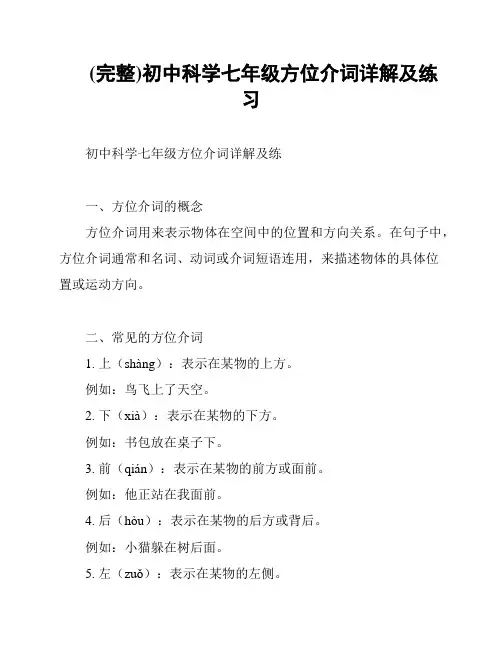
(完整)初中科学七年级方位介词详解及练习初中科学七年级方位介词详解及练一、方位介词的概念方位介词用来表示物体在空间中的位置和方向关系。
在句子中,方位介词通常和名词、动词或介词短语连用,来描述物体的具体位置或运动方向。
二、常见的方位介词1. 上(shàng):表示在某物的上方。
例如:鸟飞上了天空。
2. 下(xià):表示在某物的下方。
例如:书包放在桌子下。
3. 前(qián):表示在某物的前方或面前。
例如:他正站在我面前。
4. 后(hòu):表示在某物的后方或背后。
例如:小猫躲在树后面。
5. 左(zuǒ):表示在某物的左侧。
例如:我坐在他的左边。
6. 右(yòu):表示在某物的右侧。
例如:妈妈在我右边开车。
7. 中间(zhōng jiān):表示在某物的中间位置。
例如:篮球在两个人中间跳动。
三、方位介词的练1. 请写出下面句子中需要填写方位介词的地方:- 猫躲在椅子()面。
- 学生们排成一个长队,小明站在队()。
- 太阳从山()升起来了。
- 妹妹的书包放在桌子()。
- 老师站在黑板()。
2. 请结合实际情境,用方位介词造句,至少写出五个句子。
四、总结本文介绍了初中科学七年级方位介词的概念和常见用法,并提供了方位介词的练题,旨在帮助学生掌握方位介词的应用。
通过练,学生可以更好地描述物体的位置和方向关系。
以上是初中科学七年级方位介词详解及练习的内容,希望对您有帮助。
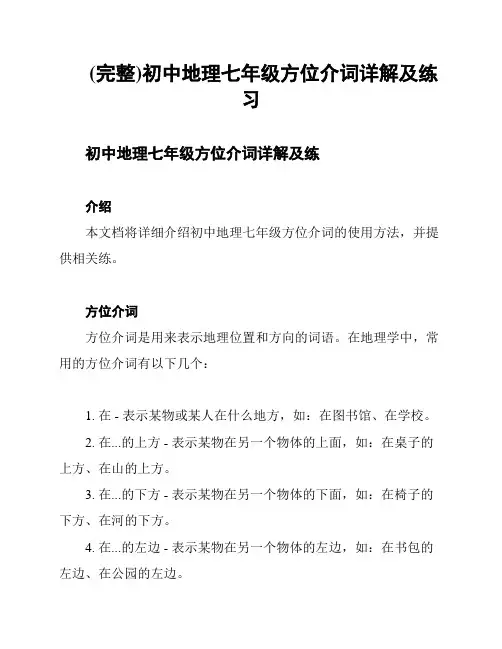
(完整)初中地理七年级方位介词详解及练
习
初中地理七年级方位介词详解及练
介绍
本文档将详细介绍初中地理七年级方位介词的使用方法,并提供相关练。
方位介词
方位介词是用来表示地理位置和方向的词语。
在地理学中,常用的方位介词有以下几个:
1. 在 - 表示某物或某人在什么地方,如:在图书馆、在学校。
2. 在...的上方 - 表示某物在另一个物体的上面,如:在桌子的上方、在山的上方。
3. 在...的下方 - 表示某物在另一个物体的下面,如:在椅子的下方、在河的下方。
4. 在...的左边 - 表示某物在另一个物体的左边,如:在书包的左边、在公园的左边。
5. 在...的右边 - 表示某物在另一个物体的右边,如:在窗户的右边、在湖的右边。
6. 在...的前面 - 表示某物在另一个物体的前面,如:在门的前面、在山的前面。
7. 在...的后面 - 表示某物在另一个物体的后面,如:在梯子的后面、在楼的后面。
练题
请根据以下描述填入合适的方位介词:
1. 我的书包 __学校门口__。
2. 我家楼下有一棵大树,我经常在大树 __玩耍__。
3. 我的书在桌子__下面__。
4. 图书馆__右边__有一个咖啡店。
5. 我住的小区__里面__有一个游泳池。
答案:
1. 在
2. 下面
3. 的左边
4. 的前面
5. 的后面
以上是初中地理七年级方位介词的详解和练习。
希望对你有帮助!。
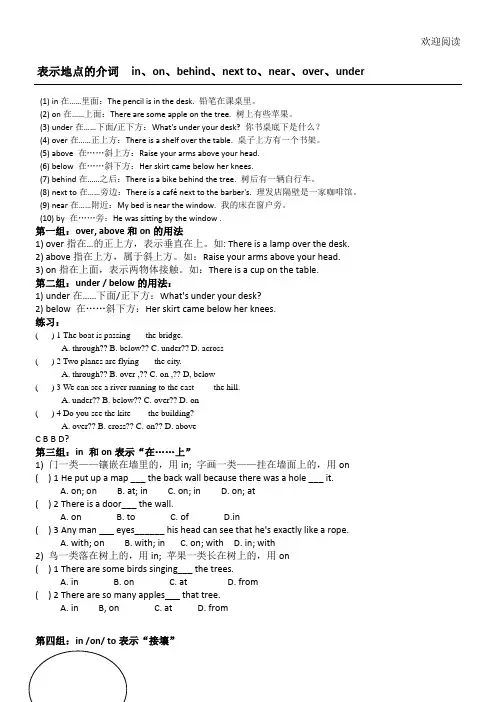
欢迎阅读表示地点的介词in、on、behind、next to、near、over、under(1) in在……里面:The pencil is in the desk. 铅笔在课桌里。
(2) on在……上面:There are some apple on the tree. 树上有些苹果。
(3) under在……下面/正下方:What's under your desk? 你书桌底下是什么?(4) over在……正上方:There is a shelf over the table. 桌子上方有一个书架。
(5) above 在……斜上方:Raise your arms above your head.(6) below 在……斜下方:Her skirt came below her knees.(7) behind在……之后:There is a bike behind the tree. 树后有一辆自行车。
A. onB. toC. ofD.in( ) 3 Any man ___ eyes______ his head can see that he's exactly like a rope.A. with; onB. with; inC. on; withD. in; with2) 鸟一类落在树上的,用in; 苹果一类长在树上的,用on( ) 1 There are some birds singing___ the trees.A. inB. onC. atD. from( ) 2 There are so many apples___ that tree.A. in B, on C. at D. from第四组:in /on/ to表示“接壤”B A B A B AB 在A里—用in A和B相邻(接壤)—用on A和B不相邻(不接壤)—用to( ) 1 The United States is ____ the south of Canada and ___ the east of Japan.A. to; in??B. on; to??C. in; beside??D. at; on( ) 2 The man stood____the window, watching the boys playing outside.?A. in??B. by??C. with??D. to( ) 3 Japan lies____ the east of China.A. on??B. to??C. in??D. with1 Tom sits____the classroom while John sits____the room.A. in front of; at back of??B. in the front of; at the back of?C. in front of; at the back of??D. in the front of; at back of2 Lucy sits____ th e third row, ____Jim‘s left.A. on; on??B. in; at??C. at; in??D. in; on3 Jiangsu is___ the east of China, but Japan is ___ the east of China.?A. to; in??B. in; to .??C. on; to??D. to; on4 Don‘t read ____ the sun. It‘s bad ___ your eyes.A. in; to??B. under; for??C. with; to??D. in; on5 The woman____ a blue dress is my teacher.A. in??B. on??C. of??D. at6 ___ research ___ the universe scientists have put a lot of information ___ computers.A. With; over; at??B. On; at; toC. In; about; into??D. For; with; through7 When a piece of ice is taken ____ a warm room, it gets smaller and smaller until ___ the end it disappears completely.A. in; in??B. out of; at??C. into; in??D. to; by练习2:5. I him myself.7. LookA inA forC March,1989D 1989,in March11.We had our breakfast ___a quarter ___sevenA /,toB in,toC at,toD on,to12. It's good manners to wait ___lineA inB onC atD with13. How many English words had you learnt ___last term?A by the end ofB at the end ofC to the end ofD till the end of14. I was born ___the night ___September 15,1978A in,on Bat,on Cat,in Don,of15. It's a bad manner to laugh ___people when they are ___troubleA over,in Bat,in C in,at D at,for16. The people's Republic of China was founded ___1949A withB onC sinceD in17. He arrived _____ Guangzhou ____ noon.A. in; inB. to; atC. in; atD. at; in18. They work _____ a small farm _____ a river.A. on; byB. at; onC. by; onD. in; in19. --When will Mr Black come to Beijing?-- ____ September 5th.A. OnB. ToC. AtD. In20. ____ the night before Christmas Day, parents fill their children’s stockings with small presents.A. Of答案:练习1:练习2:。
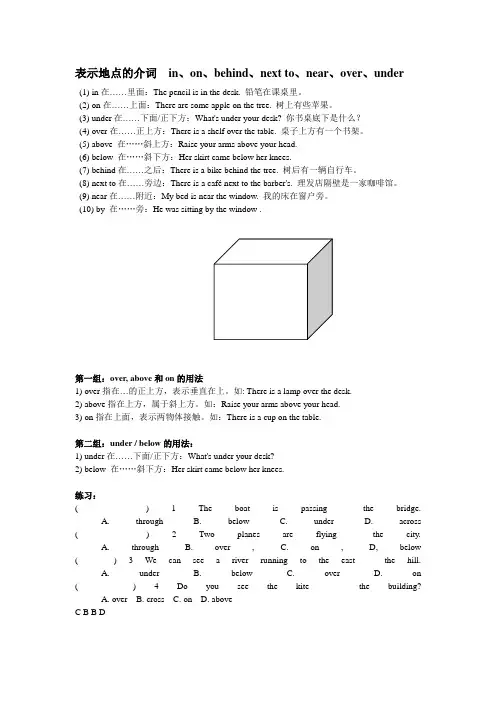
表示地点的介词in、on、behind、next to、near、over、under(1) in在……里面:The pencil is in the desk. 铅笔在课桌里。
(2) on在……上面:There are some apple on the tree. 树上有些苹果。
(3) under在……下面/正下方:What's under your desk? 你书桌底下是什么?(4) over在……正上方:There is a shelf over the table. 桌子上方有一个书架。
(5) above 在……斜上方:Raise your arms above your head.(6) below 在……斜下方:Her skirt came below her knees.(7) behind在……之后:There is a bike behind the tree. 树后有一辆自行车。
(8) next to在……旁边:There is a café next to the barber's. 理发店隔壁是一家咖啡馆。
(9) near在……附近:My bed is near the window. 我的床在窗户旁。
(10) by 在……旁:He was sitting by the window .第一组:over, above和on的用法1) over指在…的正上方,表示垂直在上。
如: There is a lamp over the desk.2) above指在上方,属于斜上方。
如:Raise your arms above your head.3) on指在上面,表示两物体接触。
如:There is a cup on the table.第二组:under / below的用法:1) under在……下面/正下方:What's under your desk?2) below 在……斜下方:Her skirt came below her knees.练习:( ) 1 The boat is passing___ the bridge.A. throughB. belowC. underD. across ( ) 2 Two planes are flying___ the city.A. throughB. over ,C. on , D, below ( ) 3 We can see a river running to the east____ the hill.A. underB. belowC. overD. on ( ) 4 Do you see the kite ___ the building?A. overB. crossC. onD. aboveC B B D第三组:in 和on表示“在……上”1) 门一类——镶嵌在墙里的,用in; 字画一类——挂在墙面上的,用on( ) 1 He put up a map ___ the back wall because there was a hole ___ it.A. on; onB. at; inC. on; inD. on; at ( ) 2 There is a door___ the wall.A. onB. toC. ofD.in ( ) 3 Any man ___ eyes______ his head can see that he's exactly like a rope.A. with; onB. with; inC. on; withD. in; with2) 鸟一类落在树上的,用in; 苹果一类长在树上的,用on( ) 1 There are some birds singing___ the trees.A. inB. onC. atD. from ( ) 2 There are so many apples___ that tree.A. in B, on C. at D. from 第四组:in /on/ to表示“接壤”B A B A B AB 在A里—用in A和B相邻(接壤)—用on A和B不相邻(不接壤)—用to( ) 1 The United States is ____ the south of Canada and ___ the east of Japan.A. to; inB. on; toC. in; besideD. at; on( ) 2 The man stood____the window, watching the boys playing outside.A. inB. byC. withD. to( ) 3 Japan lies____ the east of China.A. onB. toC. inD. with第五组:at, in表示“在……”1) at表示较小的地点。
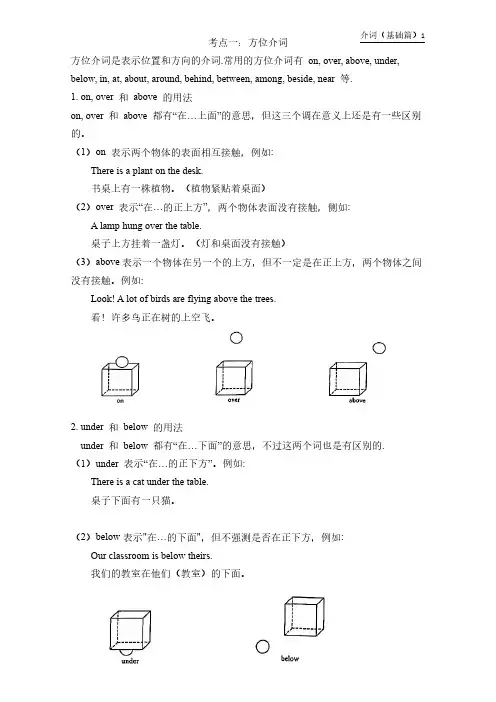
介词(基础篇)1考点一:方位介词方位介词是表示位置和方向的介词.常用的方位介词有on,over,above,under, below,in,at,about,around,behind,between,among,beside,near等.1.on,over和above的用法on,over和above都有“在…上面”的意思,但这三个调在意义上还是有一些区别的。
(1)on表示两个物体的表面相互接触,例如:There is a plant on the desk.书桌上有一株植物。
(植物紧贴着桌面)(2)over表示“在…的正上方”,两个物体表面没有接触,侧如:A lamp hung over the table.桌子上方挂着一盏灯。
(灯和桌面没有接触)(3)above表示一个物体在另一个的上方,但不一定是在正上方,两个物体之间没有接触。
例如:Look!A lot of birds are flying above the trees.看!许多鸟正在树的上空飞。
2.under和below的用法under和below都有“在…下面”的意思,不过这两个词也是有区别的.(1)under表示“在…的正下方”。
例如:There is a cat under the table.桌子下面有一只猫。
(2)below表示"在…的下面",但不强测是否在正下方,例如:Our classroom is below theirs.我们的教室在他们(教室)的下面。
介词(基础篇)2 3.in的用法in表示"在…里面",也可以用来表示在一个很大的空间内。
例如:There are some books in the box箱子里有一些书。
4.at,about和around的用法at表示"在…旁边",about或around表示"在…周围"。
(1)at表示在某物旁边。
年月周前要用in,日子前面却不行。
遇到几号要用on,上午下午又是in。
要说某日上下午,用on换in才能行。
午夜黄昏须用at,黎明用它也不错。
at也用在明分前,说“差”可要用上to。
说“过”只可使用past,多说多练牢牢记。
【知识梳理】一、介词(prep.)含义:表示它后面的名词或代词与其他句子成分的关系。
介词分类:时间介词;方位介词;方式介词介词短语:介词+名词; 动词+介词;be +形容词+介词二、表示方位的介词:1.in, to, on(1)in表示在某一地区之内的某方位(属于该范围);Fujian is in the southeast of China.(2)to表示在某一地区之外的某方位(不属于该范围);Japan is to the east of China(3)on表示与某地的毗邻关系Korea is on the east of China.2.over,above和on(1)over 指在......正上方,表垂直在上。
There is a bridge over the river.(2)above 指在上方,属于斜上方。
Raise your arms above your head(3)on指在上面,表两物体接触。
There is a plate on the table.3.at,in和on的用法区别(1)at 表示较小的地方。
at the bus stop, at home(2)in 表示较大的地方。
in China, in the world(3)on 表示在一个平面上。
on the table4.(1) in front of在......之前(范围外)。
There are some trees in front of the classroom(2) in the front of表示“在......的前部”(范围内)Our teacher usually sits in the front of the classroom.(3)before所表示的位置关系和in front of 通用,表示“在......前”,“在......面前”5.below,under(1)below表示“在下方或位置低于......”,不一定有垂直在下之意;(2) under表示“在......正下方”。
语法——方位介词Part 1:知识点1.in在……里面例句:There are many apples in the basket.篮子里有许多苹果。
2.on在……上面(有接触)例句:There is a book on the desk.桌子上有一本书。
3.over在……上面(不接触)例句:There is a bridge on the river.河上有座桥。
4.under在……下面例句:There is a ball under the chair.椅子下面有一个球。
5.before在……之前例句:Micky stands before Joe.Micky站在Joe前面。
6.behind在……后面例句:There is a tree behind the house.房子后面有一棵树。
7.beside在……旁边例句:A cat is beside the TV.电视旁边有一只猫。
8.near在……附近例句:There is a zoo neat the park.公园旁边有一个动物园。
9.next to紧挨着例句:The library is next to the gym.图书馆紧挨着体育馆。
10.i n front of在……前面例句:There is a car in front of the house.房前有一辆车。
【拓展】in the front of(在内部靠前的位置)例句:The teacher is standing in the front of the classroom.教师站在教室的前面。
11.i n the middle of在……中间例句:There is a lake in the middle of the zoo.动物园中间有一个湖。
【拓展】between在两者之间,常与and连用例句:There is a bridge between the two village.在两个村子中间有一座桥。
精品文档方位介词常用介词 in 、on 、behind 、next to 、near 、over 、under 等1)(1). in 在……里面: It is in the desk. 它在课桌里。
(2). on 在……上面: It is on the tree. 它在树上。
(3). under 在……下面/正下方:It is under a basket.他在篮子下面。
(4). over 在……正上方: There is a shelf over the table. 桌子上方有一个书架。
(5). Between 在……之间 It is between two books. 它在两本书之间。
(6). near 在……附近:It is near the window. 它在窗户旁。
(7). behind 在……之后: It is behind the tree. 它在树的后面。
(8). next to/ beside 在……旁边:It is next to/beside an apple. 它挨着苹果。
2)时间或地点介词in 、on 、at 的用法区别:表示时间时, in 表示在一段时间里(在将来时句子中则表示在一段时间之后),on 表示在具体的某一天或者某天的上下午等,at 表示在某个时刻或者瞬间;如:He was born on the morning of May 10th.(他出生于五月十日的早晨)/I usually get up at 7:00 in the morning.(我通常在早上的七点钟起床) /表示地点时, in 表示在某个范围之内,on 表示在某个平面上或与一个面相接触,at 则表示在某个具体的场所或地点。
His glasses are right on his nose.(他的眼镜就架在他的鼻子上)/He is at the cinema at the moment.(此刻他正在电影院)B A B A BAB 在A里——用in A和B相邻(接壤)——用on A和B不相邻(不接壤)——用to3) in front of “在…之前”(范围外)in the front of 表示“在…的前部”(范围内)实战演练1. The United States is ____ the south of Canada and ___ the east of Japan.A. to; inB. on; toC. in; besideD. at; on2 . Japan lies____ the east of China.A. on B/ to C. in D. with3. Jiangsu is___ the east of China, but Japan is ___ the east of China.A. to; inB. in; to .C. on; toD. to; on4. There are some trees_________ the classroomThere is a blackboard ____________ the classroom.A. in front ofB. in the front of5. —Look, there are many apples ______ the tree.—Yes. And a boy is picking apples ______ the tree now.A. in; onB. on; inC. in; inD. on; on6. When did you arrive ______school this morning?A. inB. atC. toD. with精品文档。
写出下列介词的中文意思:over:before: after: from…to…: behind:near:next to in front of:in the front of: between:in the middle of :with:in red: in English: wait for at the back of: 介词练习1:( ) 1.Tom sits____the classroom while John sits____the room.A. in front of; at back ofB. in the front of; at the back ofC. in front of; at the back ofD. in the front of; at back of( ) 2.Lucy sits____ the third row, ____Jim‘s left.A. on; onB. in; atC. at; inD. in; on( ) 3.Don‘t read ____ the sun. It‘s bad ___ your eyes.A. in; toB. under; forC. with; toD. in; on( )4.The woman____ a blue dress is my teacher.A. inB. onC. ofD. at( ) 5. A woman fell ___ the boat ___ the water.A. off; intoB. at; belowC. down; underD. away; in练习2:1. We traveled overnight to Paris and arrived _______ 5 o’clock ______ the morning.A. on; inB. at; inC. at; onD. in; on2. Look ___the map ___China ___the wall, please.A after, of, inB at, of, inC after, in, onD at, of, on3. - Please remember to come to my birthday party.- I see. I'll come ___Saturday evening.A inB atC onD for4. My brother joined the army(参军)___A 1989,MarchB in March,1989C March,1989D 1989,in March5.We had our breakfast ___a quarter(15分钟)___sevenA /,toB in,toC at,toD on,to6. I was born(出生于) ___the night ___September 15,1978A in,on Bat,on Cat,in Don,of7. China was founded (被建立于)___1949A withB onC sinceD in8. He arrived _____ Guangzhou ____ noon.A. in; inB. to; atC. in; atD. at; in9. They work _____ a small farm _____ a river.A. on; byB. at; onC. by; onD. in; in10. --When will Mr Black come to Beijing?-- ____ September 5th.A. OnB. ToC. AtD. In11. ____ the night before Christmas Day, parents fill their children’s stockings with small presents.A. OfB. AtC. ToD. On。
二、表示地点的介词in、on、behind、next to、near、over、under(1). in在……里面:The pencil is in the desk. 铅笔在课桌里。
(2). on在……上面:There are some apple on the tree. 树上有些苹果。
(3). under在……下面/正下方:What's under your desk? 你书桌底下是什么?(4). over在……正上方:There is a shelf over the table. 桌子上方有一个书架。
(5). above 在……斜上方:Raise your arms above your head.(6). below 在……斜下方:Her skirt came below her knees.(7).behind在……之后:There is a bike behind the tree. 树后有一辆自行车。
(8).next to在……旁边:There is a café next to the barber's. 理发店隔壁是一家咖啡馆。
(9).near在……附近:My bed is near the window. 我的床在窗户旁。
(10).by 在……旁:He was sitting by the window .第一组:over, above和on的用法1)over指在…的正上方,表示垂直在上。
如:There is a lamp over the desk.2)above指在上方,属于斜上方。
如:Raise your arms above your head.3)on指在上面,表示两物体接触。
如:There is a cup on the table.第二组:under / below的用法:1) under在……下面/正下方:What's under your desk?2) below 在……斜下方:Her skirt came below her knees.练习:( ) 1 The boat is passing___ the bridge.A. throughB. belowC. underD. across( ) 2 Two planes are flying___ the city.A. throughB. over ,C. on , D, below( ) 3 We can see a river running to the east____ the hill.A. underB. belowC. overD. on( ) 4 Do you see the kite ___ the building.A. overB. crossC. onD. aboveC B B D第三组:in 和on表示“在……上”1,门一类——镶嵌在墙里的,用in,字画一类——挂在墙面上的,用on( ) 1 He put up a map ___ the back wall because there was a hole ___ it.A. on; onB. at; inC. on; inD. on; at( ) 2 There is a door___ the wall.A. onB. toC. ofD.in( ) 3 Any man ___ eyes______ his head can see that he's exactly like a rope.A. with; onB. with; inC. on; withD. in; with2,鸟一类落在树上的,用in;苹果一类长在树上的,用on( ) 1 There are some birds singing___ the trees.A. inB. onC. atD. from( ) 2 There are so many apples___ that tree.A. in B, on C. at D. from第四组:in /on/ to表示“接壤”B A B A BAB 在A里——用in A和B相邻(接壤)——用on A和B不相邻(不接壤)——用to( ) 1 The United States is ____ the south of Canada and ___ the east of Japan.A. to; inB. on; toC. in; besideD. at; on( ) 2 The man stood____the window, watching the boys playing outside.A. inB. byC. withD. to( ) 3 Japan lies____ the east of China.A. on B/ to C. in D. withB B BB第五组:at, in表示“在……”1)at表示较小的地点。
如:at the bus stop, at home2)in表示较大的地点。
如:in China, in the world( ) 1 Uncle Wang arrived____ No. 14 Middle School half an hour ago.A.atB. in C to D. /( ) 2 My uncle lives ____ 88 Beijing Street.A. toB. ofC. atD. on( ) 3 They are waiting ___ a bus ___ the bus stop.A. for; inB. on; atC. with; atD. for; at第六组:in front of 和in the front of1)in front of表示“在…之前”(范围外)。
如:There are some trees in front of the classroom.2)in the front of 表示“在…的前部”(范围内)如:There is a blackboard in the front of the classroom.第七组:in / intoin表示“在……里面”,强调静态;into表示“去……里面”,强调动态。
第八组:through / across通过,穿过across表示横过,即从物体表面通过,与on有关,为二维through穿过,即从物体内部穿过,与in有关,为三维。
( ) 1 Is the street too narrow for the bus to go ___?A. throughB. acrossC. onD. in( ) 2 A mother camel was walking ___ her son ___ the desert.A. without; alongB. with; throughC. next to; passD. beside; through( ) 3 The river runs____ the city.A. acrossB. throughC. overD. from( ) 4 It took us over an hour to walk____ this street.A. fromB. throughC. overD. acrossA B B B练习1:( ) 1 Tom sits____the classroom while John sits____the room.A. in front of; at back ofB. in the front of; at the back ofC. in front of; at the back ofD. in the front of; at back of( ) 2 Lucy sits____ the third row, ____Jim‘s left.A. on; onB. in; atC. at; inD. in; on( ) 3 Jiangsu is___ the east of China, but Japan is ___ the east of China.A. to; inB. in; to .C. on; toD. to; on( ) 4Don‘t read ____ the sun. It‘s bad ___ your eyes.A. in; toB. under; forC. with; toD. in; on( ) 5The woman____ a blue dress is my teacher.A. inB. onC. ofD. at( ) 6 ___ research ___ the universe scientists have put a lot of information ___ computers. A. With; over; at B. On; at; to C. In; about; into D. For; with; through( ) 7When a piece of ice is taken ____ a warm room, it gets smaller and smaller until ___ the end it disappears completely. A. in; in B. out of; at C. into; in D. to; by ( ) 8 A woman fell ___ the boat ___ the water.A. off; intoB. at; belowC. down; underD. away; in练习2:1. We traveled overnight to Paris and arrived _______ 5 o’clock ______ the morning.A. on; inB. at; inC. at; onD. in; on2. Jack has studied Chinese in this school _______ the year of 2000.A. sinceB. inC. onD. by3. Hong Kong is ______ the south of China, and Macao is ______ the west of Hong Kong.A. in; toB. to; toC. to; inD. in; in4. Japan lies ______ the east of China.A. toB. inC. aboutD. at5. I won’t believe that the five-year-old boy can read five thousand words ______ I have tested him myself.A. afterB. whenC. ifD. until6. The book was so interesting that he had read it for three hours ______ he realized it.A. whenB. untilC. afterD. before7. Look ___the map ___China ___the wall, please.A after, of, inB at, of, inC after, in, onD at, of, on8. - Please remember to come to my birthday party.- I see. I'll come ___Saturday evening.A inB atC onD for9. They will have a maths test ___two daysA forB atC inD after10. My brother joined the army ___A 1989,MarchB in March,1989C March,1989D 1989,in March11.We had our breakfast ___a quarter ___sevenA /,toB in,toC at,toD on,to12. It's good manners to wait ___lineA inB onC atD with13. How many English words had you learnt ___last term?A by the end ofB at the end ofC to the end ofD till the end of14. I was born ___the night ___September 15,1978A in,on Bat,on Cat,in Don,of15. It's a bad manner to laugh ___people when they are ___troubleA over,in Bat,in C in,at D at,for16. The people's Republic of China was founded ___1949A withB onC sinceD in17. He arrived _____ Guangzhou ____ noon.A. in; inB. to; atC. in; atD. at; in18. They work _____ a small farm _____ a river.A. on; byB. at; onC. by; onD. in; in19. --When will Mr Black come to Beijing?-- ____ September 5th.A. OnB. ToC. AtD. In20. ____ the night before C hristmas Day, parents fill their children’s stockings with small presents.A. OfB. AtC. ToD. On答案:练习1:1-5 B D B A A 6-10 CCA练习2:1-5 BAAAD 6-10 DDCCB 11-15 CAADB 16-20 DCAAD。